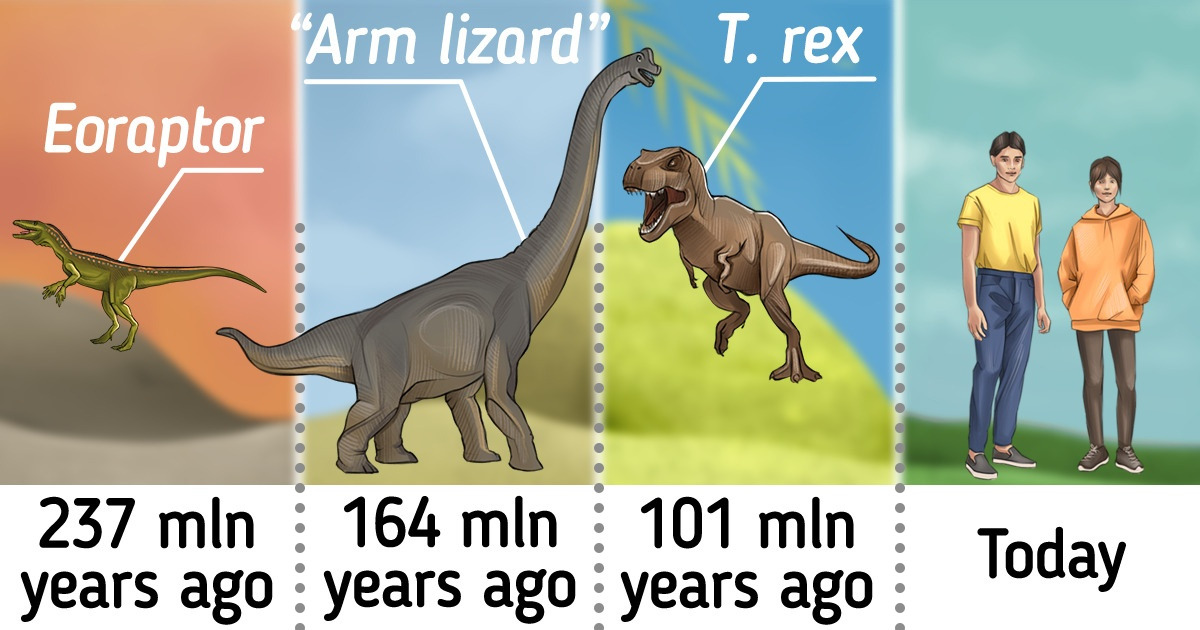
Types of Dinosaurs You Ought to Know About

There were many different types of dinosaurs way back when, and they were around for about 165 million years. There were around 700 valid species. Although dinosaurs are now extinct, it’s no secret that these animals were truly amazing, no matter the type. Read this article to learn more about them.
Timeline and types of dinosaurs
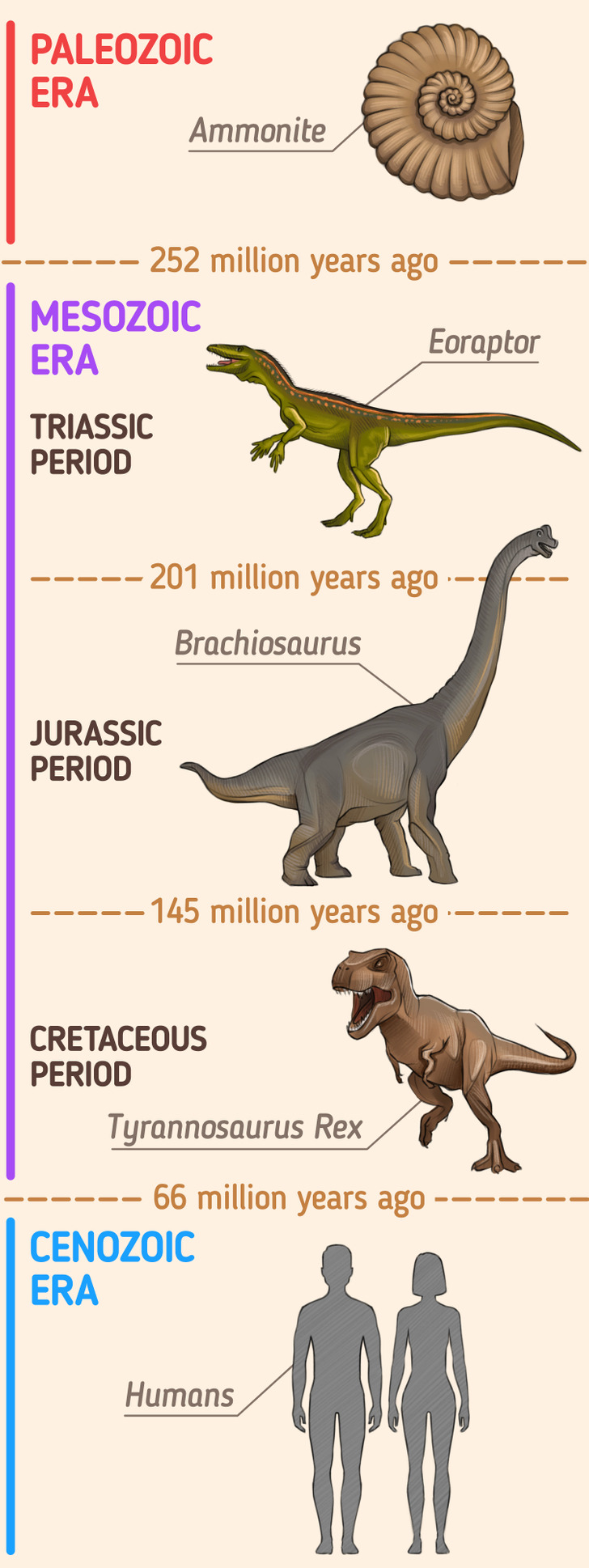
The first dinosaurs appeared in the Late Triassic Period (in the Mesozoic Era that came after the Paleozoic Era). They were dominant until the Late Cretaceous period after which the Cenozoic Era started.
Here is the exact timeline:
- Late Triassic Period: 237 to 201 million years ago
- Early Jurassic Period: 201 to 174 million years ago
- Mid Jurassic Period: 174 to 164 million years ago
- Late Jurassic Period: 164 to 145 million years ago
- Early Cretaceous Period: 145 to 101 million years ago
- Late Cretaceous Period: 101 to 66 million years ago
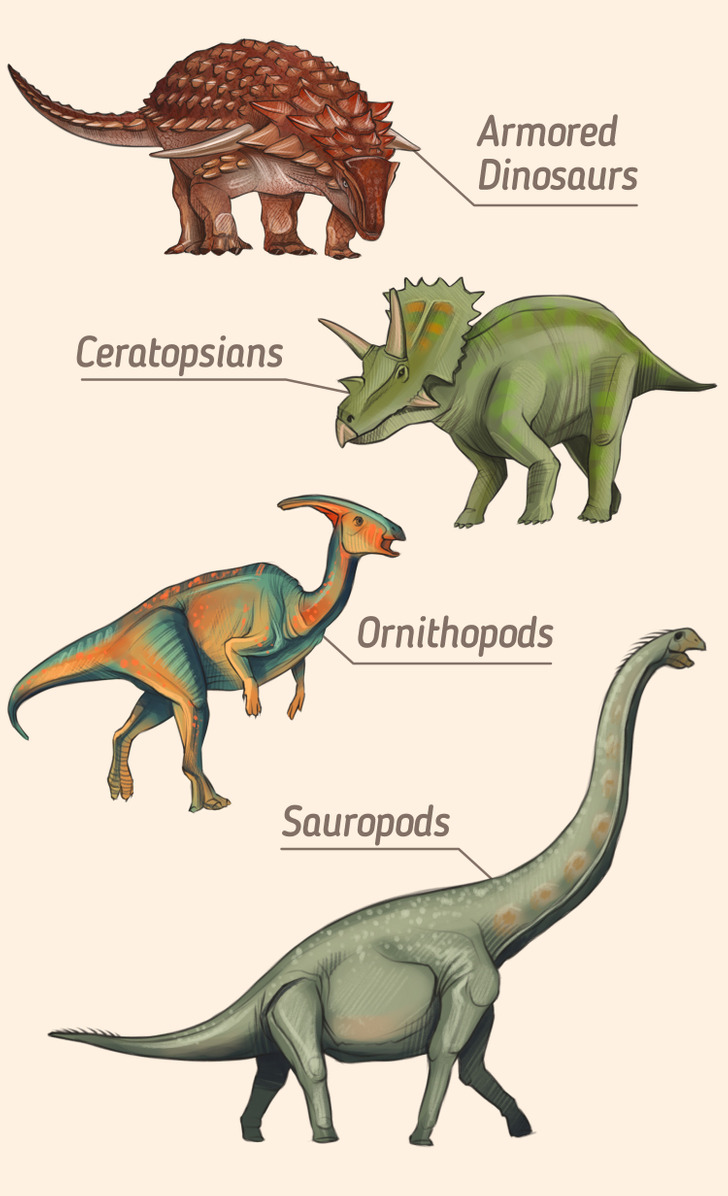
Dinosaur classification is very complex, as it includes different genera, species, names, and families. Here is the simple classification of dinosaurs based on their appearance and eating habits:
- Armored dinosaurs: These were 4-legged herbivores with medium-sized bodies covered with armor and sometimes spikes on their tails.
- Ceratopsians: These dinosaurs ate plants and had parrot-like beaks. They also had distinctive bones around their heads that looked like frills, and many had horns too.
- Ornithopods: This is another herbivore-type dinosaur that had a medium-sized body and could walk on 2 legs.
- Sauropods: They had very long necks, tails, and large bodies. Their diet was herbivorous and they mostly walked on 4 legs. Sauropods were the largest reptiles that ever walked the Earth.
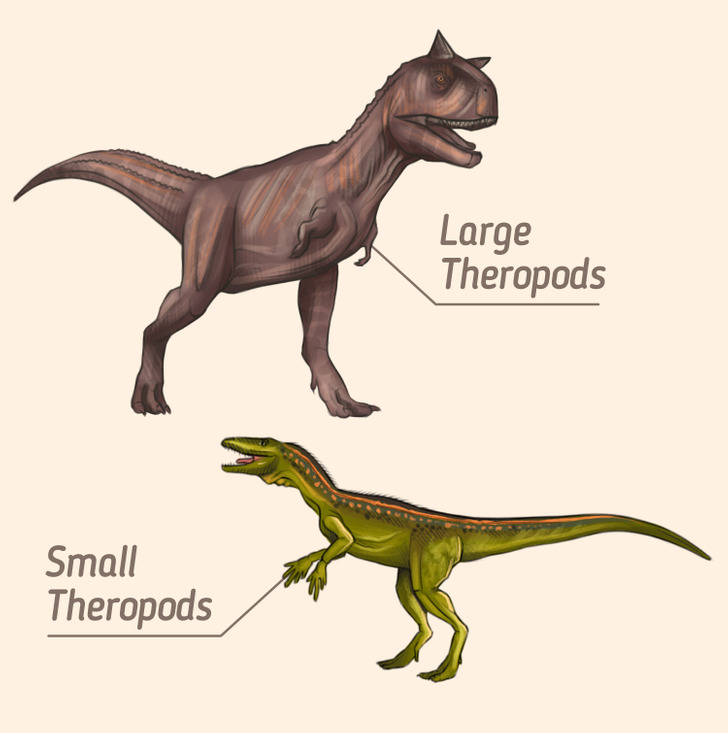
- Large Theropods: Carnivorous dinosaurs that had powerfully developed hind limbs and could use them for walking and running. They used their forelimbs for grasping and tearing up their prey.
- Small Theropods: Similar to large theropods, they were bipeds but smaller in size. Their diet varied from meat to plants to insects, and some of them had feathers. Birds descended from this lineage.
1. Dinosaurs in the Late Triassic Period (237 to 201 million years ago)
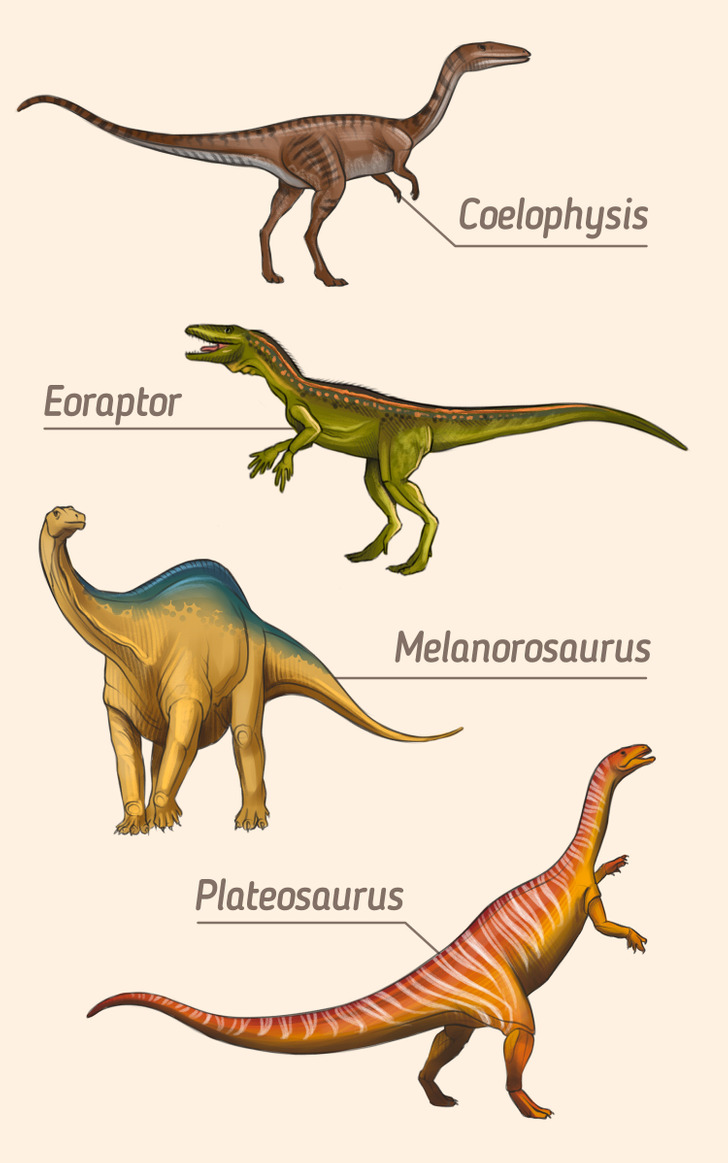
- Coelophysis: These were small carnivorous dinosaurs that walked on 2 legs. They had sharp teeth and claws, which they used to catch their prey.
- Eoraptor: This was one of the earliest dinosaurs. This carnivorous predator could move on its 2 back legs but wasn’t very tall — its height was around 1.5 ft (0.5 m).
- Melanorosaurus: Also called the “black mountain lizard,” this was one of the earliest sauropods that lived on Earth. They were omnivores.
- Plateosaurus: These herbivores had 5 fingers on their front limbs and a large thumb claw.
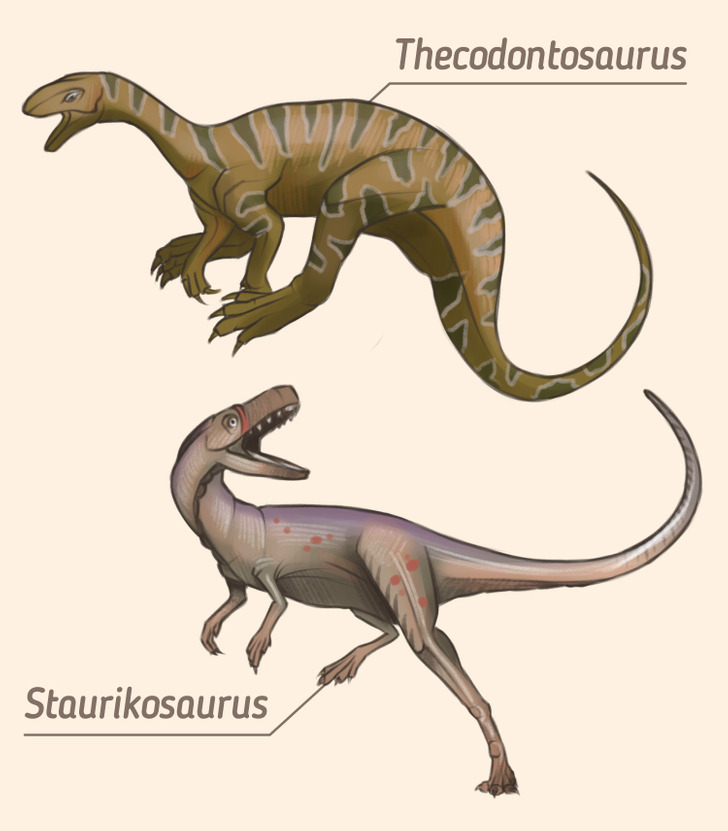
5. Thecodontosaurus: these small bipedal dinosaurs were one of the first dinosaurs to be discovered. Their diet consisted mostly of plants, but they were probably omnivores. Unfortunately, many fossils of the Thecodontosaurus were destroyed during World War 2.
6. Staurikosaurus: or the “Southern Cross lizards” were carnivorous, small, agile, and quick, which allowed them to catch tiny prey.
2. Dinosaurs in the Early Jurassic Period (201 to 174 million years ago)
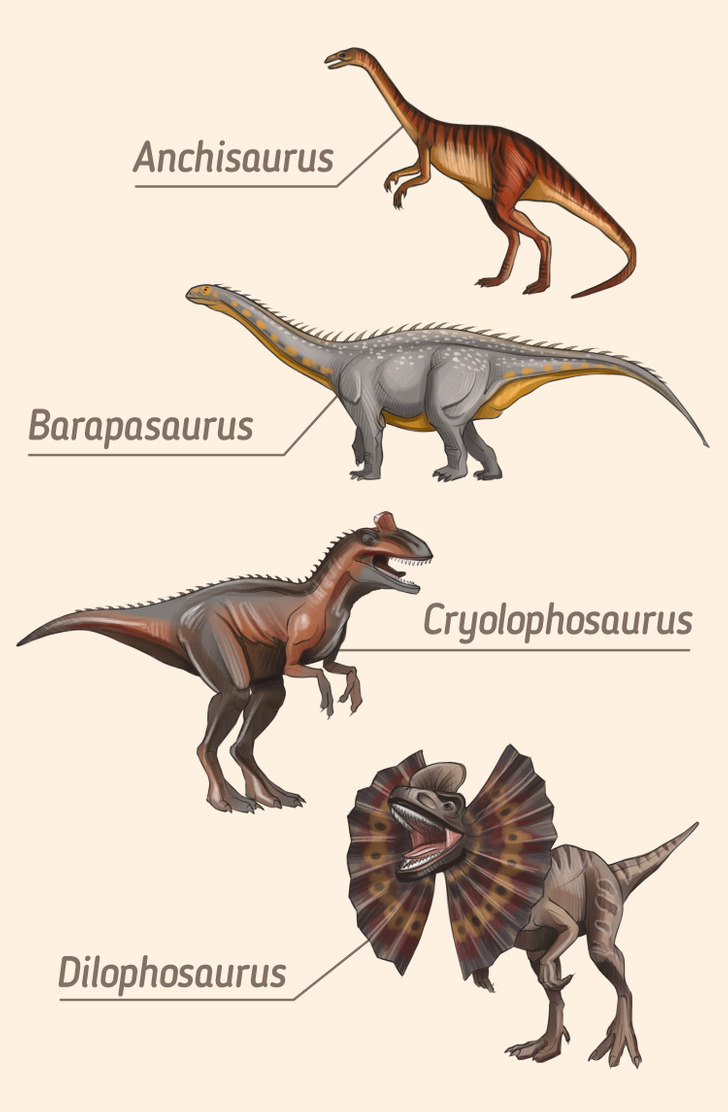
- Anchisaurus: These herbivore species inhabited the area of North America and were small dinosaurs, weighing around 20 kg to 30 kg.
- Barapasaurus: This was a big sauropod that lived in what is now modern-day India and ate plants. It’s one of the earliest known sauropods.
- Cryolophosaurus: This theropod lived in what is now Antarctica, was a carnivore, and had a little crest on the top of the head.
- Dilophosaurus: These dinosaurs were carnivorous predators with strong jaws. Something else that’s interesting about these dinosaurs is that they had a pair of arched crests on their skulls.
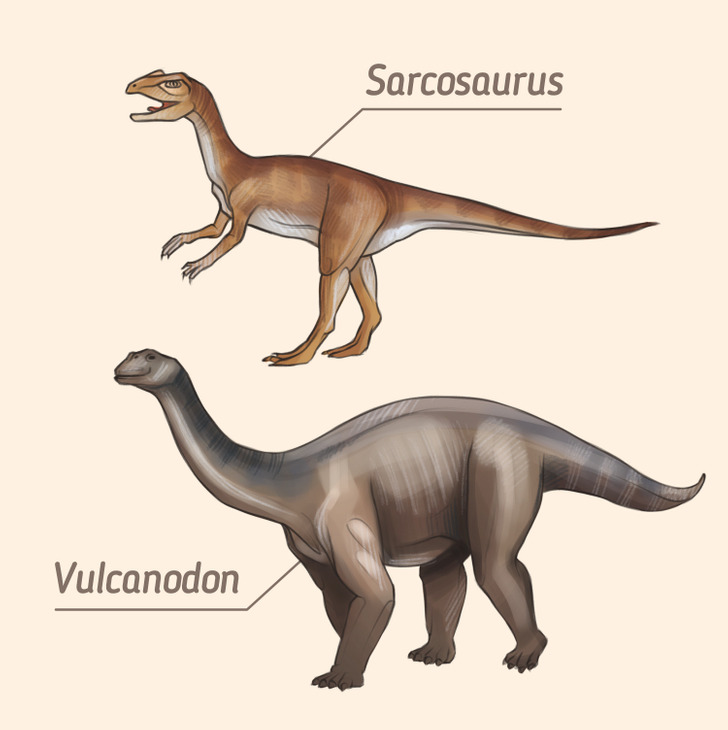
3. Dinosaurs in the Mid Jurassic Period (174 to 164 million years ago)
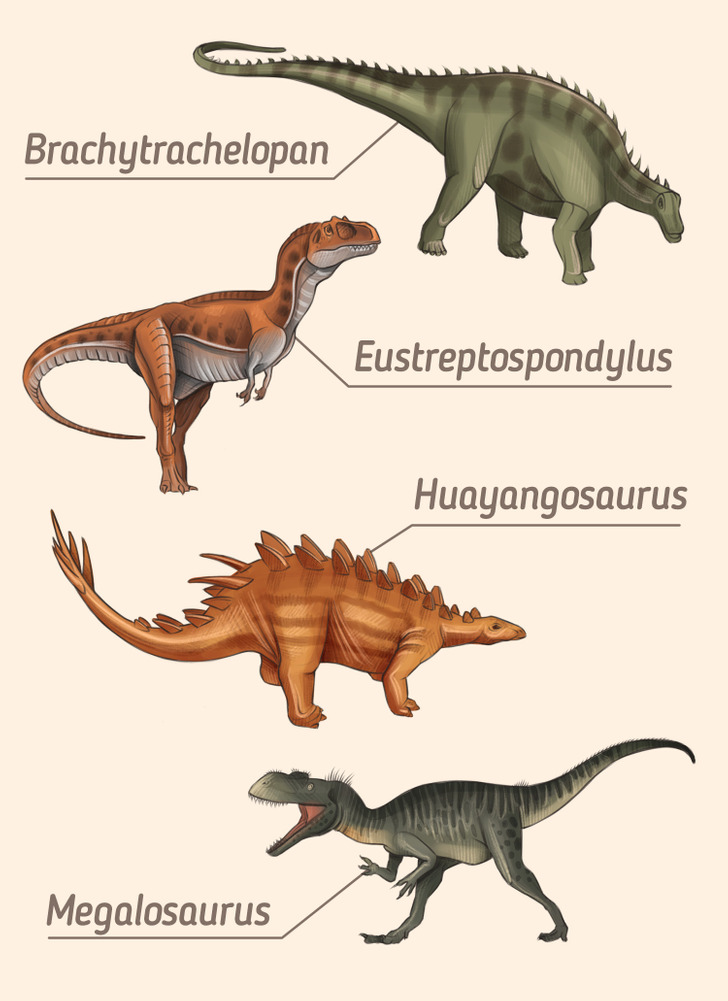
- Brachytrachelopan: This herbivore was a sauropod but, unlike the others, it had a short neck.
- Eustreptospondylus: This was a large predator that hunted other smaller dinosaurs and was a scavenger.
- Huayangosaurus: These were armored dinosaurs with many small plates that went down their back along with a spiky tail.
- Megalosaurus: This large reptile was one of the first to be discovered and validly named (the first bone fragment from this dinosaur was found in 1676). It was a carnivore and had very sharp teeth.
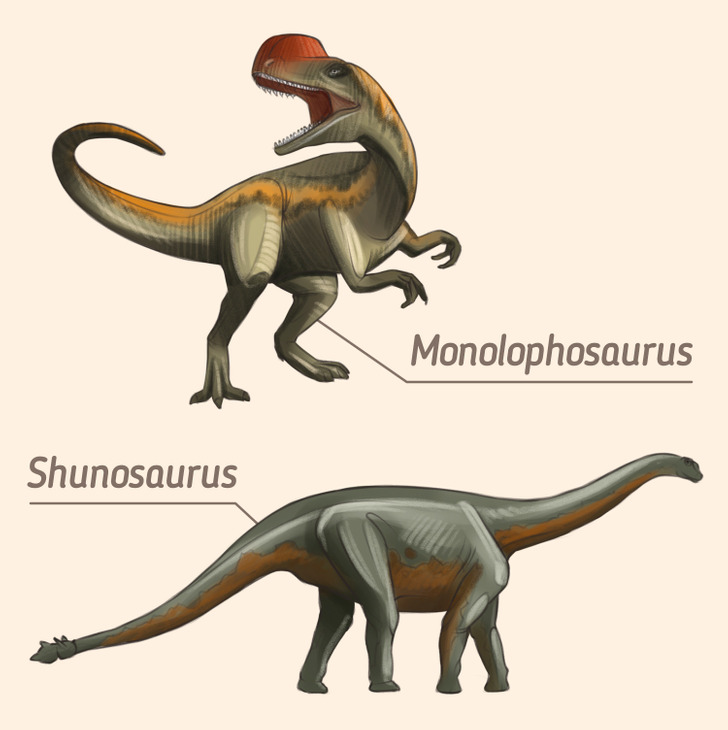
4. Dinosaurs in the Late Jurassic Period (164 to 145 million years ago)
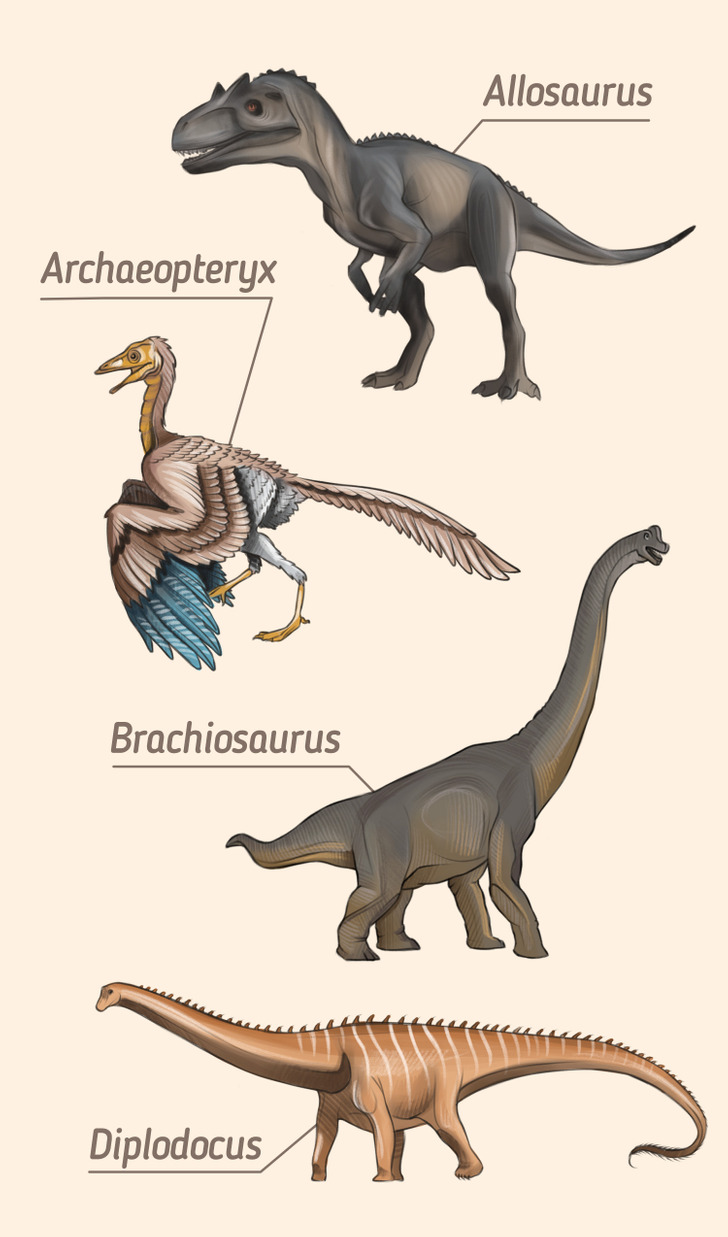
- Allosaurus: This was a Carnosaurian predator with dagger-like teeth and serrated edges that prevented prey from running away.
- Archaeopteryx: This was a small carnivorous dinosaur that had feathers and a long tail. People consider the remains of this dinosaur to be transitional fossils between non-avian dinosaurs and birds.
- Brachiosaurus: Its name, in fact, means “arm lizard” because of its disproportionately long arms. It is estimated that this herbivore was between 59 and 69 feet tall, and it had a disproportionately long neck.
- Diplodocus: Here’s another sauropod that is very easy to identify, as it is very popular. It also had a very long, whip-like tail that was probably used to fend off enemies.
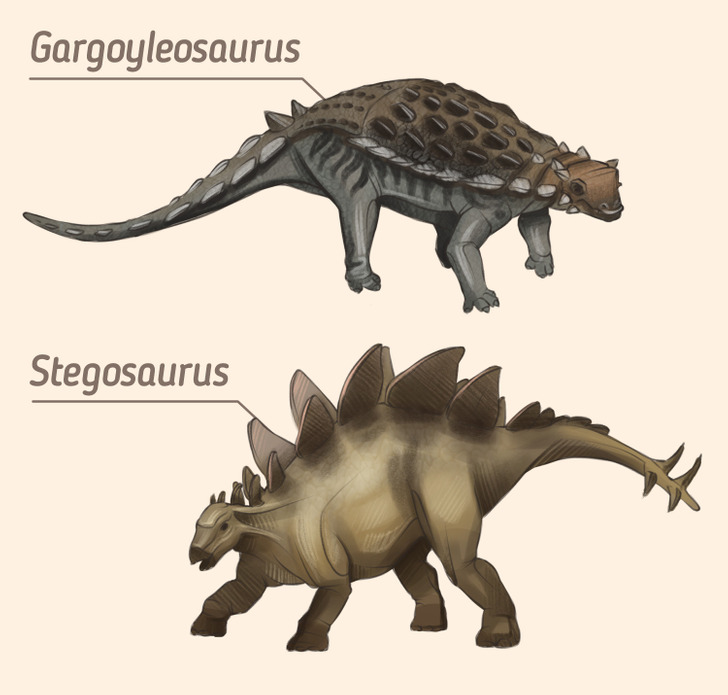
5. Gargoyleosaurus: This herbivore was one of the first known armored-type dinosaurs. It moved on 4 legs and had plates on its head and body.
6. Stegosaurus: Another 4-legged herbivore with distinctive armor on its back. The armor consisted of kite-shaped plates that were positioned upright on their back and they also had spikes on their tails.
5. Dinosaurs in the Early Cretaceous Period (145 to 101 million years ago)
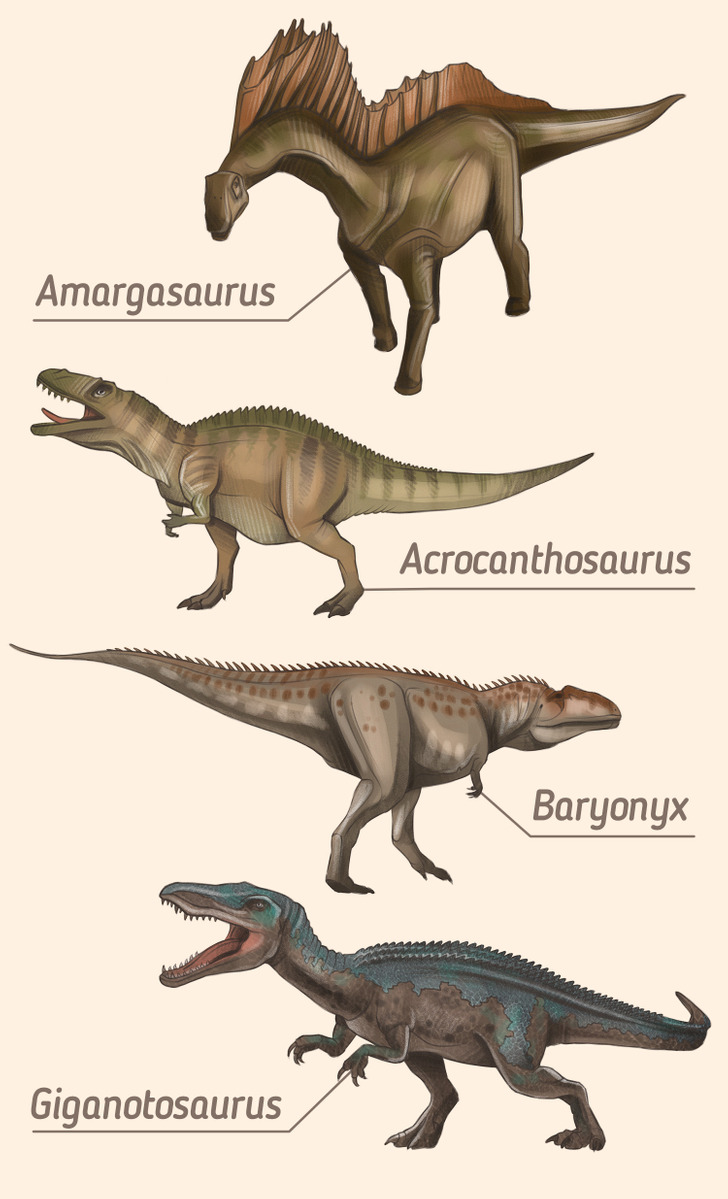
- Amargasaurus: This herbivorous sauropod had double parallel rows of tall spines down its back. This posture probably supported the skin sail that was used for display, combat, or defense.
- Acrocanthosaurus: This was one of the largest carnivorous theropods. It had a very high spine that probably supported its strong muscle form.
- Baryonyx: A carnivorous dinosaur that had very sharp, serrated teeth. Its mouth was similar to the ones that crocodiles have. They probably hunted fish in shallow water but were also scavengers.
- Giganotosaurus: They looked like a slimmer Tyrannosaurus Rex dinosaur, but taller and longer. These carnivorous dinos had blade-like teeth that were ideal for slicing.
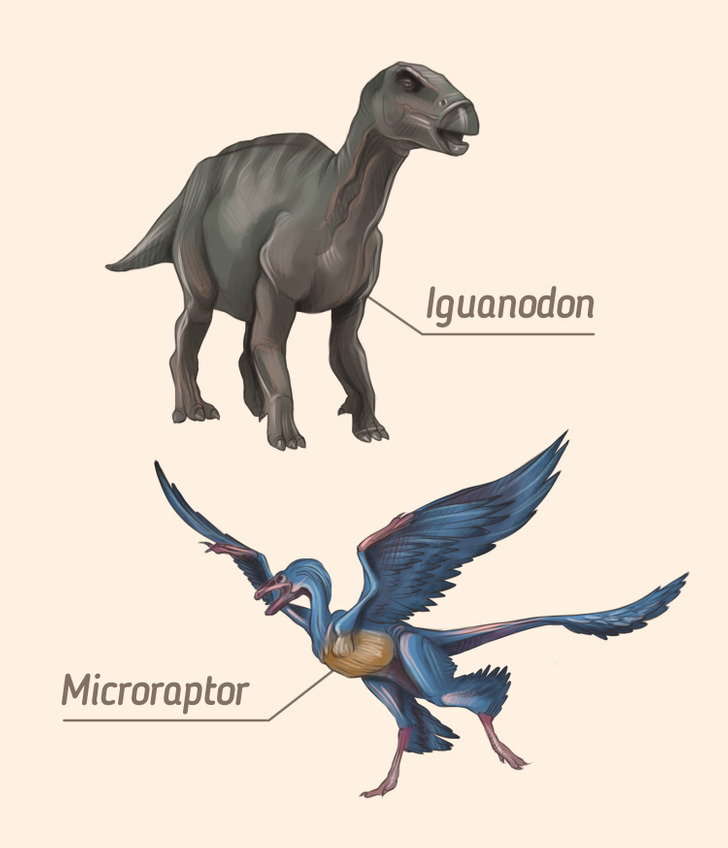
5. Iguanodon: They were herbivores that could walk on 2 or 4 legs and had teeth similar to an iguana, but bigger. Also, scientists believe they had long tongues due to the muscle structure inside their head.
6. Microraptor: A small carnivore that had feathers on all 4 limbs. Scientists believe that this dinosaur was probably capable of gliding through the air which supports evidence about the evolutionary connection between birds and dinosaurs.
6. Dinosaurs in the Late Cretaceous Period (101 to 66 million years ago)
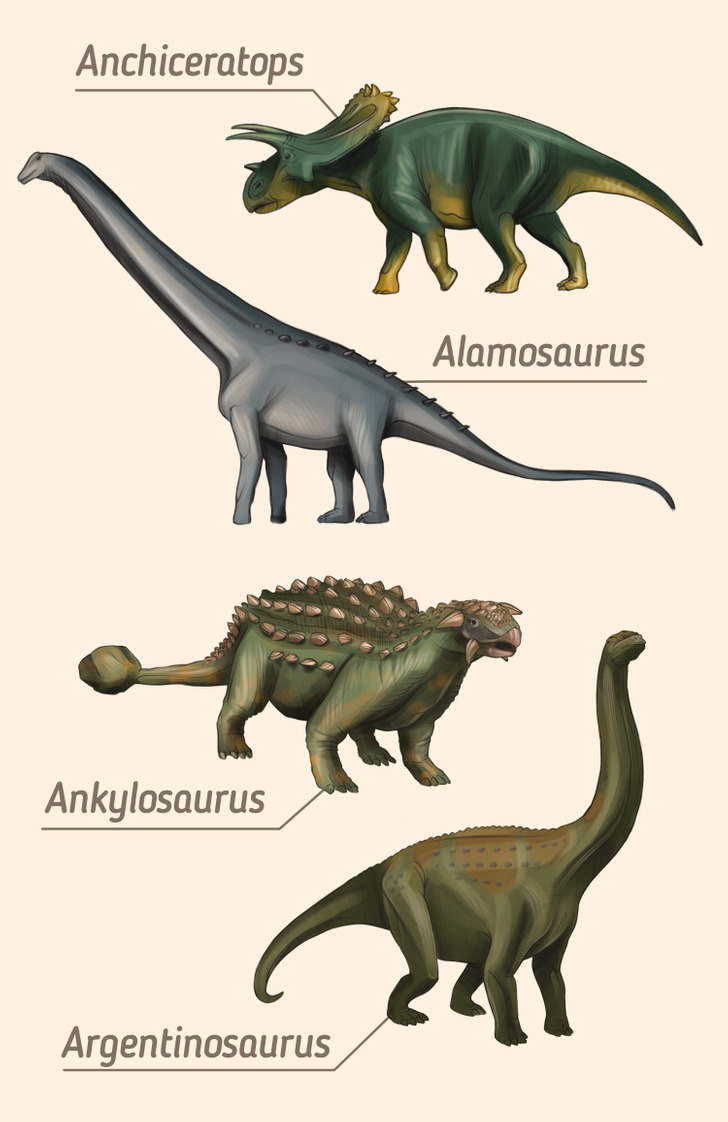
- Alamosaurus: This is the largest dinosaur ever found in North America. Like other sauropods, it had a long neck, long tail, and the body was partly covered in armor bones.
- Anchiceratops: A strong-built herbivore that had 2 horns in the brow area, one small horn on the nose, and also a skull with frills that had little triangles on the edges.
- Ankylosaurus: They had a very robust body covered in armor plates. Their skull was also heavily armored and this herbivore had a large tail club.
- Argentinosaurus: This dinosaur is the largest land animal found so far (the length is estimated to be from 30 to 39.7 meters). It belongs to the Titanosauria family, which was the dominant group of sauropods throughout the Cretaceous period.
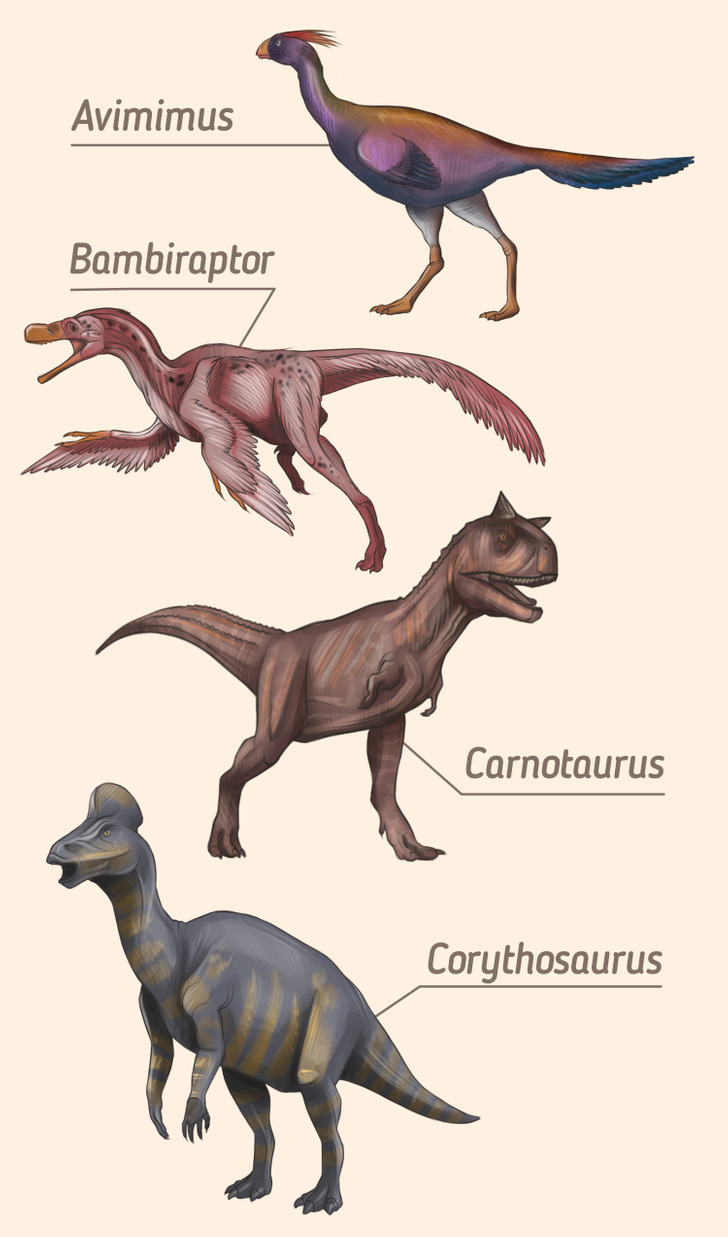
5. Avimimus: This omnivore dinosaur was named after its many bird-like characteristics. It was small with a beak similar to the ones that parrots have.
6. Bambiraptor: Another dinosaur that resembled a bird, walked on 2 legs, and ate meat. It probably had feathers and could run as fast as a chicken.
7. Carnotaurus: A large, meat-eating theropod that could probably run very fast on its 2 legs. It had 2 thick horns above the eyes, which was uncommon to see on carnivorous dinosaurs.
8. Corythosaurus: Herbivorous dinosaur that had a crest on its head that resembled a Corinthian helmet from ancient Greece. Researchers believe that the function of the crest was to make sounds.
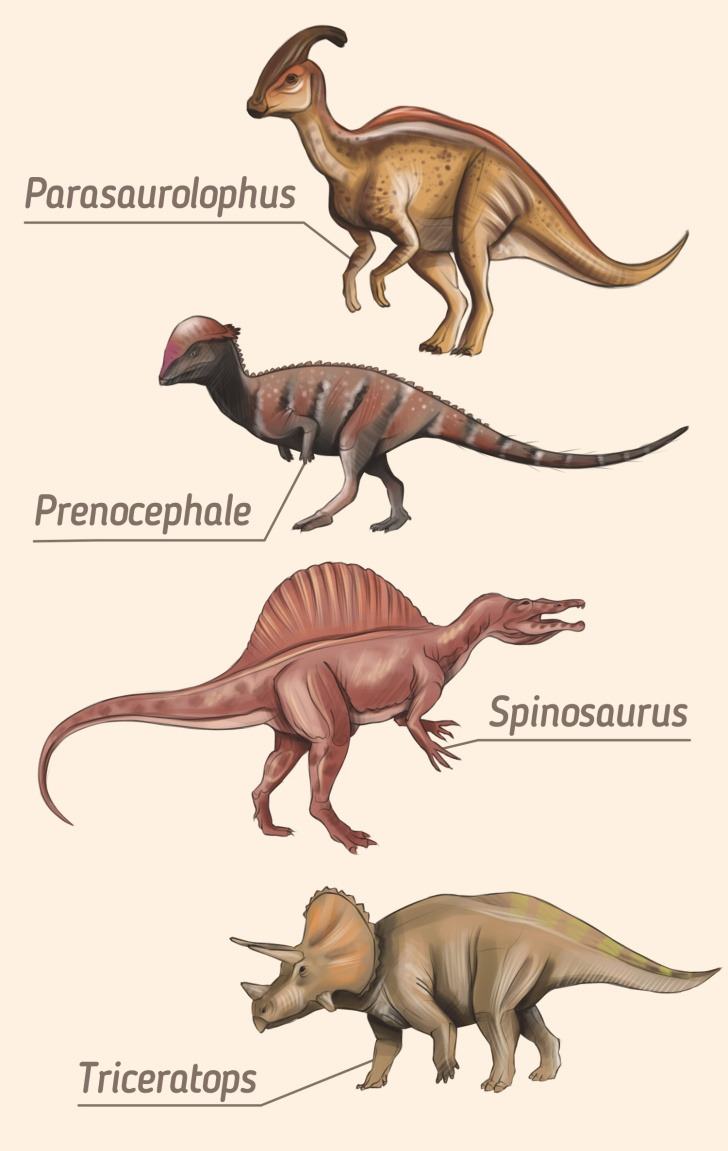
9. Parasaurolophus: This herbivore was a hadrosaurid, a member of a dinosaur family that had various head enhancements like crests, spikes, or tubes. Parasaurolophuses had a very long, crested tube which they probably used for communication.
10. Prenocephale: An ornithopod that had a helmet-like head and ate plants. Their skull was round and sloping.
11. Spinosaurus: This was the largest terrestrial carnivore. Spinosaurus had a sail-back feature and a long, narrow jaw, similar to a crocodile’s mouth.
12. Triceratops: A very recognizable dinosaur, with a bony-frilled skull, with 2 horns emerging from the brow area and one horn in the nose area. The puncture marks that were found on one of the frill fossils show that they used their horns to fight other Triceratops or fend off attacks from Tyrannosauruses.
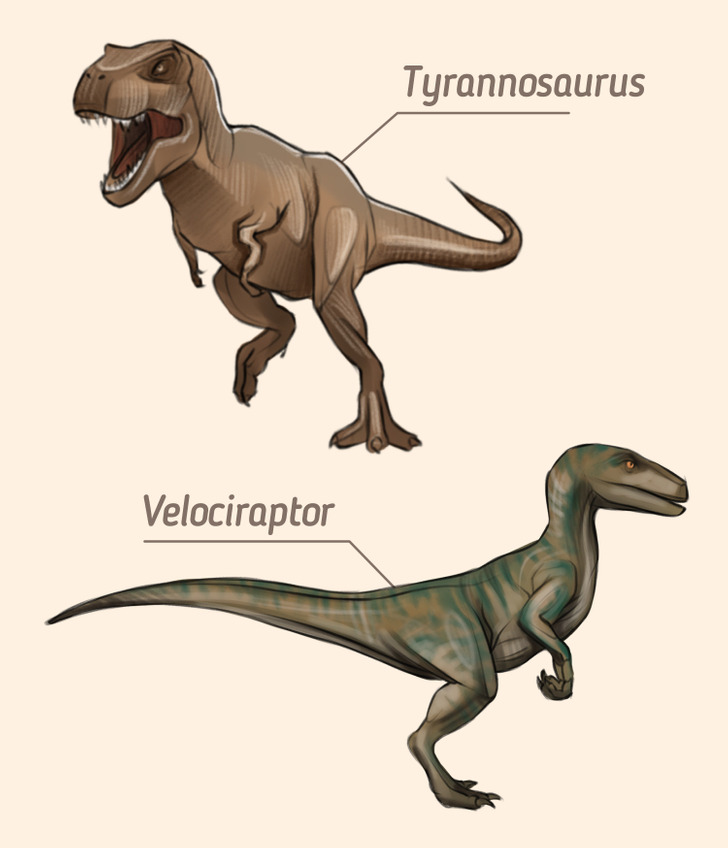
13. Tyrannosaurus: Probably the most reputable dinosaur and one of the biggest theropods that ever lived. This 2-legged carnivore had a massive and powerful jaw with 60 teeth that could crunch through the bones of Triceratops. Although Tyrannousauruses had a very muscular physique, they weren’t very fast as often depicted in popular movies.
14. Velociraptor: This dinosaur was roughly the size of a turkey and had a long skull with serrated teeth. Although this carnivore had feathers, it couldn’t fly.
Dinosaurs can also be divided into avian and non-avian dinosaurs. All non-avian dinosaurs are extinct, but avian dinosaurs still live on — we just call them birds. Which dinosaur species do you like best? Are they any different from what you had pictured?